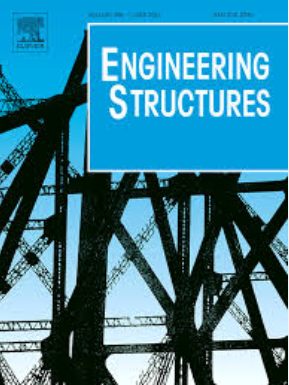Investigation on fatigue performance and life prediction of PBL connectors in steel-UHPC composite structure
IF 5.6
1区 工程技术
Q1 ENGINEERING, CIVIL
引用次数: 0
Abstract
This paper presents an investigation into the fatigue performance and life prediction of perfobond strip connectors (PBLs) in steel-ultra-high performance concrete (UHPC) composite structure, based on three static push-out tests and nine fatigue tests. From the three static push-out tests results, the fatigue load and load amplitude for fatigue tests are determined. A comparative analysis is then conducted on the fatigue life, failure modes, slip curves, shear stiffness degradation laws and failure mechanisms of PBL connectors under static and fatigue loading conditions. Two-stage fatigue cumulative damage mode applicable to PBL connectors in UHPC is then proposed. Finally, based on above analysis, the fatigue life prediction model of the PBL connectors in UHPC is proposed and validated by experimental results. The results indicate that the load amplitude remains the primary factor affecting the fatigue life of PBL connectors. The fatigue cumulative damage of PBL connectors in UHPC is more unstable compared to that of PBL connectors in normal concrete, showing three-stage fatigue cumulative damage under small load amplitude and five-stage fatigue cumulative damage under large load amplitude. The final failure mode of PBL connectors in UHPC under static and fatigue test is characterized by the fracture of the transverse rebar, whereas in normal concrete, the failure mode primarily involves the crushing and splitting of the concrete slab at the PBL connectors. The fatigue damage of PBL connectors in UHPC more accurately is divided into two stages: the UHPC-dominated damage stage and the transverse rebar-dominated damage stage. The fatigue life prediction model of PBL connectors is proposed and validated by experimental results.
求助全文
约1分钟内获得全文
求助全文
来源期刊

Engineering Structures
工程技术-工程:土木
CiteScore
10.20
自引率
14.50%
发文量
1385
审稿时长
67 days
期刊介绍:
Engineering Structures provides a forum for a broad blend of scientific and technical papers to reflect the evolving needs of the structural engineering and structural mechanics communities. Particularly welcome are contributions dealing with applications of structural engineering and mechanics principles in all areas of technology. The journal aspires to a broad and integrated coverage of the effects of dynamic loadings and of the modelling techniques whereby the structural response to these loadings may be computed.
The scope of Engineering Structures encompasses, but is not restricted to, the following areas: infrastructure engineering; earthquake engineering; structure-fluid-soil interaction; wind engineering; fire engineering; blast engineering; structural reliability/stability; life assessment/integrity; structural health monitoring; multi-hazard engineering; structural dynamics; optimization; expert systems; experimental modelling; performance-based design; multiscale analysis; value engineering.
Topics of interest include: tall buildings; innovative structures; environmentally responsive structures; bridges; stadiums; commercial and public buildings; transmission towers; television and telecommunication masts; foldable structures; cooling towers; plates and shells; suspension structures; protective structures; smart structures; nuclear reactors; dams; pressure vessels; pipelines; tunnels.
Engineering Structures also publishes review articles, short communications and discussions, book reviews, and a diary on international events related to any aspect of structural engineering.
 求助内容:
求助内容: 应助结果提醒方式:
应助结果提醒方式:


